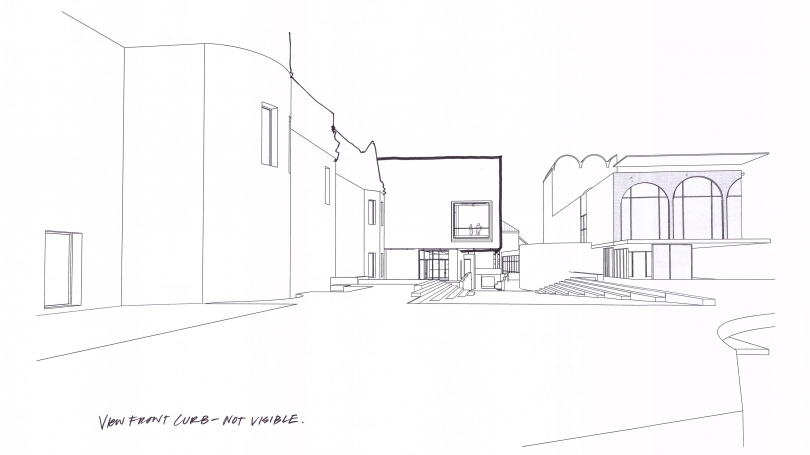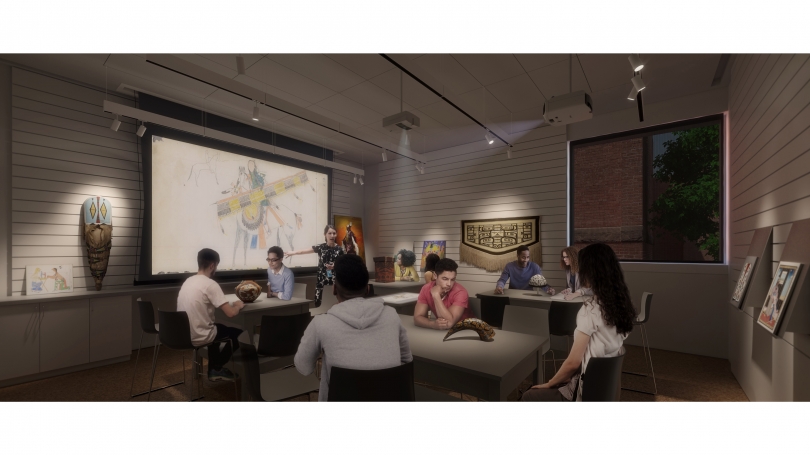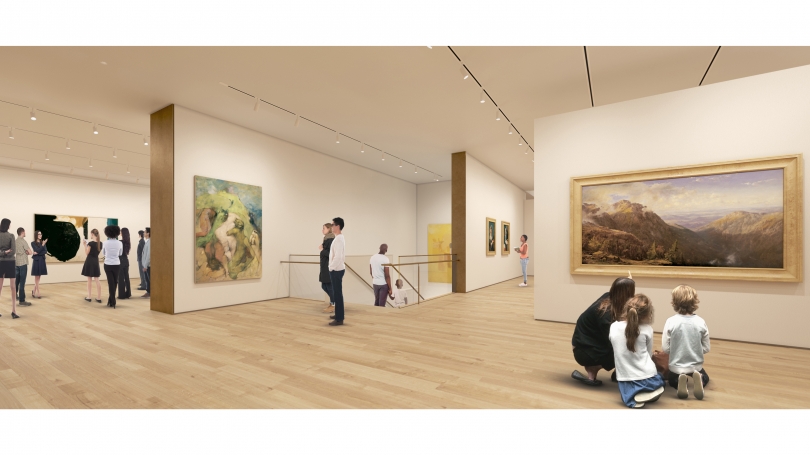The Hood Museum of Art is excited to announce the ambitious expansion and renovation of its facility, set to begin later this year. We anticipate closing the museum in mid-March, with excavation, construction, and reinstallation likely to continue until 2019 (Dartmouth’s 250th anniversary). Along the way, you will have many exciting and new opportunities to stay connected to the Hood through programs, special exhibitions, and partnerships on campus and in the community, as well as activity online!
With architects Tod Williams and Billie Tsien and their team, as well as our colleagues in the Dartmouth President’s, Provost’s, and Campus Planning Offices, the Hood staff has immersed itself in this purpose-driven expansion and renovation project to revitalize a thirty-year-old institution with a much longer history behind it. Dartmouth’s collections are among the oldest and largest of any college or university in the country, but it was not until the Charles Moore–designed Hood Museum of Art opened its doors in 1985 that they were all united under one roof and made available to faculty, students, and the public. When first accredited in 1990, the Hood was already described by the American Association of Museums (now the American Alliance of Museums) as “a national model” for college and university museums. The museum has been consistently accredited since then, and also subsequently labeled “as fine a museum as one can find in this country.” What we have learned during these decades has brought national attention to the Hood’s success, and has informed every step of planning for the future.
Through this project, the museum renews its commitment to teaching and learning with objects of artistic and cultural significance, with a reinvigoration of how we practice. We will triple our teaching capacity from one study-storage room to three smart object-study classrooms in the museum’s new Center for Object-Based Inquiry (COBI). We will expand our galleries by a third to accommodate the display of art from different cultural and historical periods in a variety of media. Finally, we will add a gracious new public concourse that will serve as a flexible gathering and event space, as well as a welcoming entry into the museum and COBI. Most importantly, this renovation and expansion will ensure that the museum fulfills its mission to create a learning environment that fosters transformative educational encounters with art for everyone!
The Hood Museum of Art expansion is exemplary of Dartmouth’s emphasis on experiential learning and is one of several ambitious, high-profile initiatives advanced by President Philip J. Hanlon ’77, and supported by the Board of Trustees, that will build on the College’s existing strengths, bring even greater distinction to Dartmouth, and, most critically, have a profound impact on the lives of students. “Williams and Tsien have presented us with an inspired design that will transform the Hood in many ways, making it a front door for the arts at Dartmouth,” says President Hanlon. “Their plan puts our teaching mission front and center where it belongs and presents an ideal environment for experiential learning, one that will make the Hood a national model teaching museum for the 21st century.”
The Architects
Tod Williams and Billie Tsien are internationally acclaimed architects recognized for their rich modernist and meditative style and their vast portfolio of cultural and institutional buildings. The couple received the American Institute of Architects Architecture Firm Award in 2013 and the National Medal of Arts from President Barack Obama in 2014. Among their many notable projects are the David Rubenstein Atrium at Lincoln Center, New York; the Barnes Foundation museum, Philadelphia; the Reva and David Logan Center for the Arts, University of Chicago; the C. V. Starr East Asian Library, University of California, Berkeley; and the Asia Society Hong Kong Center, Hong Kong.
The Concourse and the North Plaza
The bolder character of the reimagined Hood begins at its entrance. All visitors will pass through the North Plaza, sure to be a natural meeting place that will welcome those arriving at the Hood from any direction on campus. The North Plaza will invite conversations and impromptu performances on its many gentle steps and supply an inspirational setting for sculpture and signage. Just inside the main entrance, the museum concourse is one of the signature spaces in the expanded Hood. In addition to orienting visitors to the museum, the concourse will be a flexible venue for events, with space for receptions, dinners, and intimate performances.
The Learning Spaces
The Center for Object-Based Inquiry will boast three new object-study classrooms to create unparalleled opportunities for study and research in a museum setting, addressing the increased curricular demand for direct engagement with original works. By integrating technology in their design, the new object-study rooms will better enable faculty to contextualize objects through the use of film, the Internet, the Hood’s comprehensive database of its collection, and other forms of new media. Students will also have the opportunity to communicate directly with artists, art historians, and critics to delve even more deeply into the creation, context, and meaning of individual works.
The Galleries
The Hood expansion will add five new galleries, designed to showcase the museum’s extensive and diverse collection and encourage interdisciplinary teaching and learning for all audiences through objects from the collection. These spaces will accommodate the display of art from different cultural and historical periods in a variety of media. Planned in concert with the curricular needs of Dartmouth and the interest of the greater community, the galleries will feature frequent rotations of objects to fully capitalize upon the richness of the collection and present new and engaging experiences for repeat visitors.


